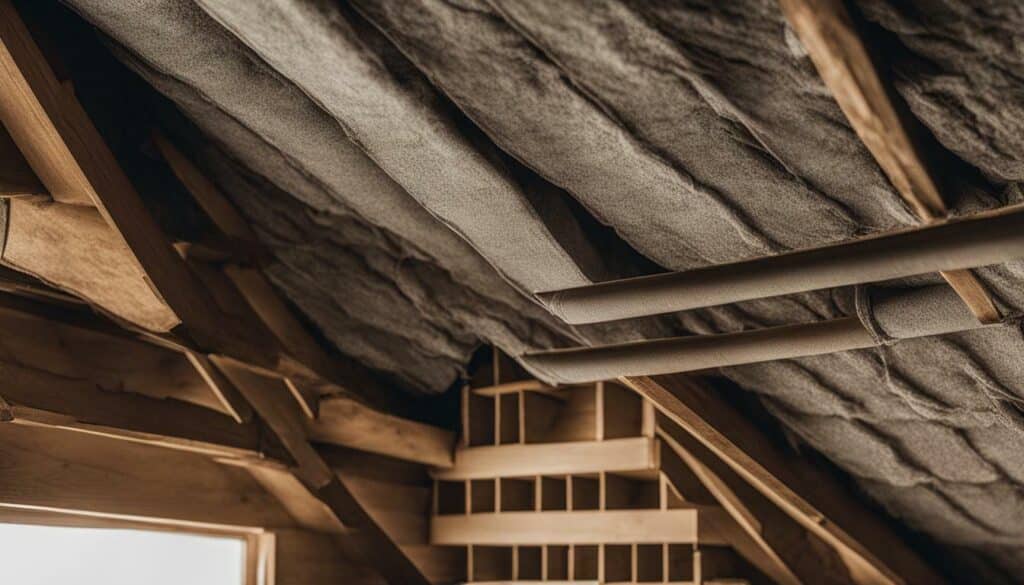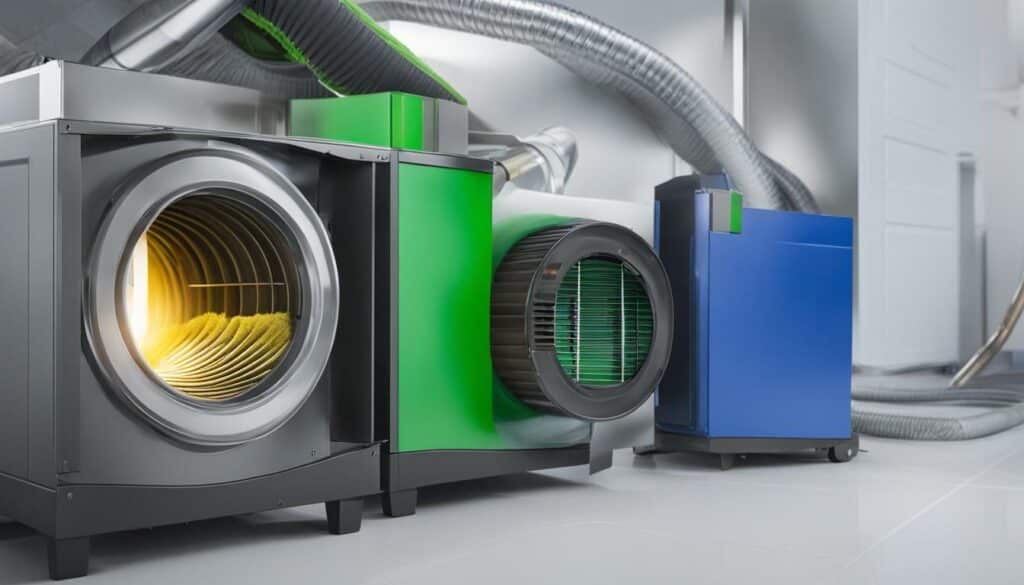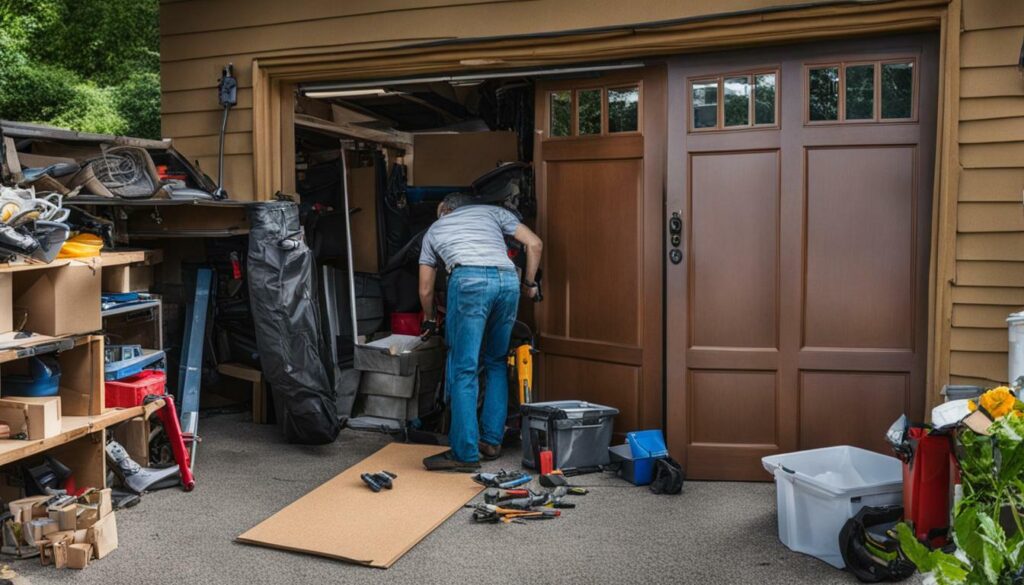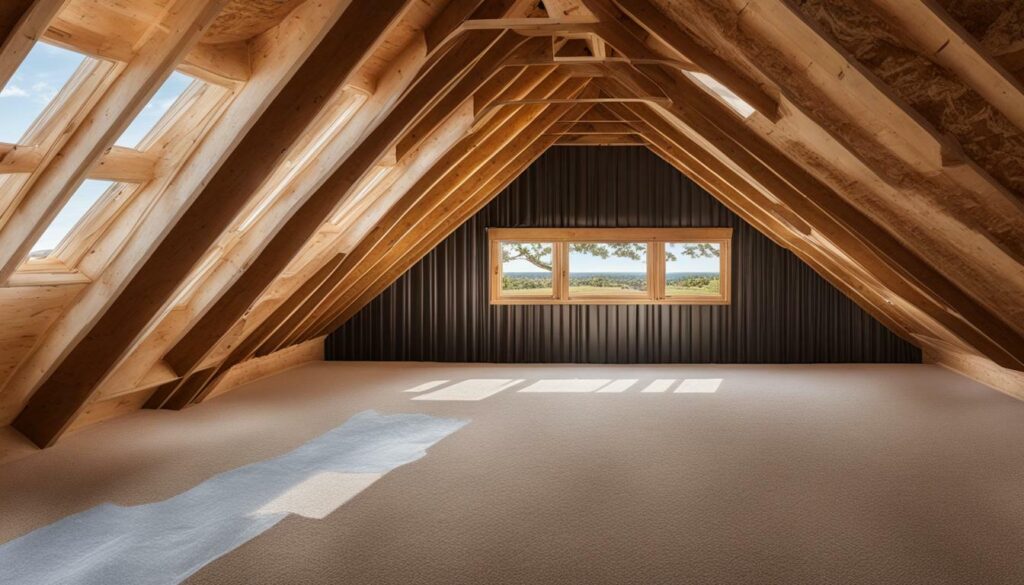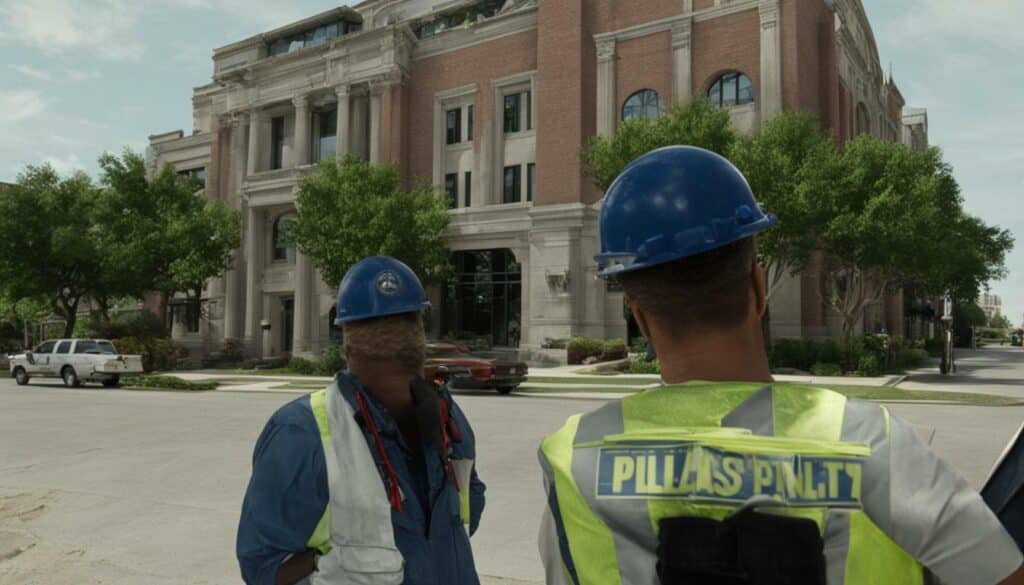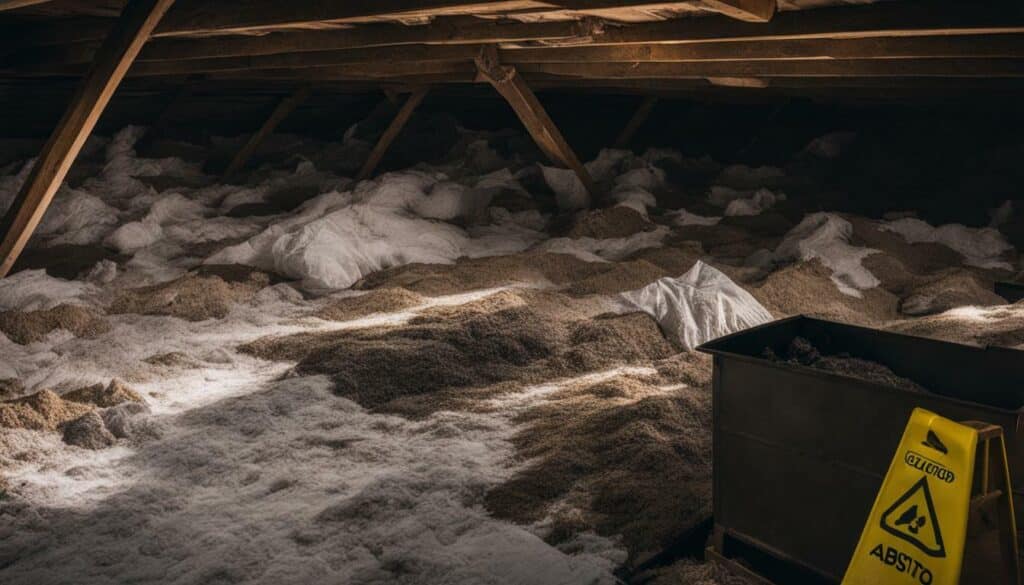
If you suspect your attic may have asbestos insulation, it’s crucial to know how to identify the signs and take appropriate action. To determine if your attic has asbestos insulation, there are a few key factors to consider. First, the year your house was built plays a significant role, as many older homes constructed before 2000 may contain asbestos insulation. Vermiculite insulation, which looks like little pebbles with a grayish-brown or silvery-gold color, is a common type of insulation that often contains asbestos. Another clue is the texture and color of the insulation. Asbestos insulation may appear as pebble-like vermiculite or as corrugated, gray or off-white pipe insulation. It’s important to note that although some insulation materials, like fiberglass, cellulose, and mineral wool, rarely contain asbestos, it’s always best to have a professional attic specialist inspect and test the insulation to be certain. If asbestos is confirmed, it’s recommended to hire a certified asbestos removal company to handle the safe removal and disposal process.
- Consider the year your house was built, as older homes constructed before 2000 may have asbestos insulation.
- Look for vermiculite insulation, which often contains asbestos and has a grayish-brown or silvery-gold appearance.
- Pay attention to the texture and color of the insulation, as asbestos insulation may appear as pebble-like vermiculite or corrugated, gray or off-white pipe insulation.
- While some insulation materials rarely contain asbestos, it’s always best to have a professional inspect and test your attic insulation to be certain.
- If asbestos is confirmed, hire a certified asbestos removal company to safely handle the removal and disposal process.
Understanding Asbestos and its Risks
Before we delve into identifying asbestos in your attic, it’s essential to understand what asbestos is, why it was commonly used as insulation, and the potential health risks it poses.
Asbestos is a naturally occurring mineral fiber that was extensively used in the past for its heat resistance and insulating properties. It was commonly found in building materials, including attic insulation, due to its ability to withstand high temperatures. However, the use of asbestos has been banned or heavily regulated in many countries due to its hazardous nature.
Exposure to asbestos fibers can lead to serious health issues, including lung diseases such as asbestosis, lung cancer, and mesothelioma. These diseases may take years or even decades to develop after exposure, making it crucial to take proactive measures to minimize the risk.
To identify the presence of asbestos in your attic, several signs can help guide you. Older homes constructed before 2000 are more likely to have asbestos insulation, especially if it contains vermiculite insulation. Vermiculite insulation is characterized by small pebbles with a grayish-brown or silvery-gold color and often contains asbestos.
Additionally, the texture and color of the insulation can provide clues. Asbestos insulation may appear as pebble-like vermiculite or as corrugated, gray or off-white pipe insulation. It’s important to note that while some insulation materials such as fiberglass, cellulose, and mineral wool rarely contain asbestos, it’s always best to consult a professional attic specialist for a thorough inspection and testing to ensure accurate identification.
If asbestos is confirmed in your attic, it’s crucial to hire a certified asbestos removal company to handle the safe removal and disposal process. Attempting to remove asbestos insulation without proper training and equipment can release harmful fibers into the air, putting your health and the health of others at risk.
Remember, identifying and dealing with asbestos is not something to be taken lightly. It’s always better to err on the side of caution and seek professional guidance to ensure the safety of yourself and your loved ones.
| Key Points: |
|---|
| Asbestos was commonly used as insulation due to its heat resistance. |
| Exposure to asbestos fibers can lead to serious lung diseases. |
| Signs of asbestos insulation in the attic include vermiculite insulation and specific texture and color. |
| Consult a professional attic specialist for accurate identification and testing. |
| Hire a certified asbestos removal company for safe removal and disposal. |
Factors to Consider in Identifying Asbestos
There are several key factors to consider when trying to determine if your attic insulation contains asbestos. One of the most important factors is the age of your home. Asbestos was commonly used as insulation in residential buildings before 2000, so if your house was built prior to that, there is a higher likelihood that your attic insulation may contain asbestos.
Another factor to consider is the appearance of the insulation. Asbestos insulation can come in different forms, such as pebble-like vermiculite or corrugated pipe insulation. Vermiculite insulation with a grayish-brown or silvery-gold color is often associated with asbestos presence. It’s important to note that visually inspecting the insulation is not enough to confirm the presence of asbestos. Only professional testing can provide an accurate determination.
When in doubt, it’s always best to have a professional attic specialist inspect and test your insulation. They have the knowledge and expertise to identify asbestos and can conduct proper sampling and analysis. Professional testing involves taking samples of the insulation and sending them to a certified laboratory for analysis. The results will determine whether your insulation contains asbestos and the appropriate steps to take for removal, if necessary.
| Key Factors to Consider | Insulation Appearance | Insulation Age |
|---|---|---|
| Age of Home | Vermiculite insulation | Pre-2000 construction |
| Professional Inspection | Corrugated pipe insulation | Visual inspection not enough |
| Lab Testing | Professional sampling and analysis | Accurate determination |
“It’s always best to err on the side of caution and seek professional inspection and testing. The health risks associated with asbestos exposure make it crucial to handle any potential asbestos-containing insulation with care.” – Attic Specialist
Identifying Asbestos
Identifying asbestos in your attic insulation requires careful consideration of various factors, including the age of your home and the appearance of the insulation. While visual clues can provide some indication, professional inspection and testing are necessary for accurate confirmation. Always prioritize your safety and consult with certified professionals for proper assessment and, if needed, removal of asbestos insulation.
Asbestos insulation in the attic can have unique visual clues that can help in identification. One common type of asbestos insulation is vermiculite, which resembles little pebbles with a grayish-brown or silvery-gold color. If you notice this type of insulation in your attic, it is important to exercise caution as it may contain asbestos.
Another visual clue is the texture and color of the insulation. Asbestos insulation can appear as corrugated, gray or off-white pipe insulation. It may also have a pebble-like texture, similar to vermiculite. These visual characteristics should raise a red flag and prompt further inspection and testing.
| Visual Clues of Asbestos Insulation | |
|---|---|
| Texture | Pebble-like or corrugated |
| Color | Gray, off-white, or silvery-gold (vermiculite) |
| Appearance | Commonly found in pipe insulation or as vermiculite pebbles |
While these visual clues can indicate the presence of asbestos insulation, it is important to note that visual inspection alone cannot confirm the presence of asbestos. It is recommended to have a professional attic specialist inspect and test the insulation to obtain accurate results. Professional testing is necessary because other insulation materials, such as fiberglass, cellulose, and mineral wool, can resemble asbestos insulation in appearance but do not pose the same health risks.
If asbestos insulation is confirmed, it is crucial to enlist the services of a certified asbestos removal company. They have the expertise and equipment to safely remove and dispose of the asbestos insulation, minimizing the risk of exposure to harmful asbestos fibers.
Professional Inspection and Testing
To accurately determine if your attic has asbestos insulation, it is crucial to enlist the help of a certified professional for inspection and testing. Asbestos fibers are microscopic and cannot be identified visually, making it essential to rely on specialized equipment and expertise.
A professional attic specialist will conduct a comprehensive inspection of your attic and insulation materials. They will collect samples of the insulation and send them to a certified laboratory for analysis. The laboratory will use polarized light microscopy or transmission electron microscopy to identify the presence of asbestos fibers.
During the inspection and testing process, it is important to limit any disturbances to the insulation, as disturbing asbestos can release harmful fibers into the air. Certified professionals follow strict protocols to minimize the risk of asbestos exposure and ensure the safety of both occupants and workers.
| Benefits of Professional Inspection and Testing |
|---|
| Accurate identification of asbestos presence |
| Minimization of asbestos exposure risk |
| Knowledgeable guidance on further actions |
“Professional inspection and testing are the only reliable methods to confirm the presence of asbestos insulation in your attic. It is crucial to prioritize safety and seek the assistance of certified professionals to ensure accurate results and proper handling of asbestos-containing materials.”
- If the test results confirm the presence of asbestos insulation, it is recommended to consult with an asbestos removal company that specializes in safe abatement procedures.
- Do not attempt to remove or disturb asbestos insulation on your own, as it can pose a serious health risk. Professional asbestos removal companies have the expertise, equipment, and protective gear necessary to handle the removal process safely.
- Follow the guidance provided by the asbestos removal company to ensure that all necessary precautions are taken during the removal and disposal process.
Remember, the presence of asbestos insulation in your attic should not be ignored. Taking prompt action with the help of professionals can protect the health and well-being of you and your loved ones.
Risks and Safe Removal of Asbestos
If asbestos is found in your attic, it is essential to understand the risks involved and take the necessary steps for safe removal. Asbestos can be hazardous to your health if the fibers are released into the air and inhaled. Prolonged exposure to asbestos fibers can cause serious respiratory illnesses, including lung cancer and mesothelioma.
To ensure the safe removal of asbestos insulation, it is recommended to hire a certified asbestos removal company. These professionals have the necessary training and equipment to handle asbestos safely. They will follow strict protocols to minimize the release of fibers during the removal process.
During the removal, the asbestos insulation will be carefully contained to prevent contamination of other areas of your home. Specialized tools and techniques will be used to safely remove the insulation without disturbing the fibers. Once the asbestos has been removed, it will be properly sealed and disposed of in accordance with local regulations.
It’s important to remember that attempting to remove asbestos insulation yourself can be extremely dangerous. Disturbing the asbestos without proper precautions can release a significant amount of fibers into the air, putting yourself and others at risk of exposure. Always leave asbestos removal to the professionals.
| Risks of Asbestos in Attic | Safe Removal Process |
|---|---|
| Exposure to asbestos fibers can lead to respiratory illnesses, including lung cancer and mesothelioma. | Hire a certified asbestos removal company to handle the safe removal process. |
| Attempting to remove asbestos yourself can release fibers into the air, increasing the risk of exposure. | Professionals will follow strict protocols to minimize the release of fibers during the removal process. |
| Proper containment and disposal of asbestos insulation is crucial to prevent contamination. | Asbestos will be carefully contained and sealed during removal, and disposed of in accordance with regulations. |
Importance of Professional Asbestos Removal
Professional asbestos removal ensures that the process is conducted safely and effectively. These experts have the knowledge, experience, and equipment to handle asbestos insulation properly. They will perform thorough inspections, followed by proper containment, removal, and disposal.
- Inspection: Professionals will inspect your attic to identify the extent of asbestos contamination.
- Containment: Strict containment measures will be implemented to prevent the spread of asbestos fibers.
- Removal: Specialized techniques and equipment will be used to safely remove the asbestos insulation.
- Disposal: Asbestos waste will be sealed and disposed of according to local regulations.
- Clearance Testing: After removal, professionals will conduct clearance testing to ensure the area is free of asbestos fibers.
Common Misconceptions about Asbestos
There are several misconceptions surrounding the identification of asbestos insulation in attics, and it’s important to separate fact from fiction. One common misconception is that all attic insulation contains asbestos. While asbestos was a popular insulation material in the past, not all insulation materials used in attics contain asbestos. Fiberglass, cellulose, and mineral wool are examples of insulation materials that rarely contain asbestos.
Another misconception is that you can visually identify asbestos insulation by its appearance. While there are some visual clues that may indicate the presence of asbestos, such as the texture and color of the insulation, visual inspection alone is not enough to confirm the presence of asbestos. Asbestos fibers are microscopic and cannot be seen with the naked eye. To be certain, it is best to have a professional attic specialist inspect and test the insulation.
Some may also believe that if their attic insulation is old, it must contain asbestos. While older homes are more likely to have asbestos insulation, it is not a guarantee. Asbestos insulation was used until the early 2000s, and even then, there were alternative materials being used. Therefore, the age of your home is a factor to consider, but it is not the sole determining factor.
Ultimately, the only way to confirm the presence of asbestos insulation in your attic is through professional inspection and testing. Certified asbestos abatement companies have the necessary equipment and expertise to safely handle and remove asbestos if it is found. It is important to prioritize safety and seek professional assistance to ensure the proper identification and removal of asbestos insulation in your attic.
FAQs
- Q: How can I tell if my insulation is asbestos?
- A: Visual inspection alone is not enough to determine if your insulation contains asbestos. It is best to have a professional attic specialist inspect and test the insulation.
- Q: Does all attic insulation contain asbestos?
- A: No, not all attic insulation contains asbestos. Insulation materials such as fiberglass, cellulose, and mineral wool rarely contain asbestos.
- Q: Is it safe to remove asbestos insulation myself?
- A: It is not recommended to remove asbestos insulation yourself. Asbestos removal should be done by certified asbestos abatement professionals to ensure safety.
| Myth | Fact |
|---|---|
| All attic insulation contains asbestos | Not all attic insulation contains asbestos. Fiberglass, cellulose, and mineral wool are commonly used insulation materials that rarely contain asbestos. |
| You can visually identify asbestos insulation | Visual inspection alone is not enough to confirm the presence of asbestos. Professional inspection and testing are required for accurate identification. |
| All old attic insulation contains asbestos | While older homes are more likely to have asbestos insulation, the age of your home does not guarantee the presence of asbestos. Professional inspection is necessary for confirmation. |
Alternatives to Asbestos Insulation
If you discover that your attic contains asbestos insulation, it’s crucial to explore safer alternatives, such as fiberglass insulation. Fiberglass insulation is a popular choice for homeowners looking to replace asbestos insulation due to its effectiveness, affordability, and safety. Made from spun glass fibers, fiberglass insulation provides excellent thermal and sound insulation properties.
One of the advantages of fiberglass insulation is that it does not contain asbestos. Unlike asbestos, fiberglass insulation is non-toxic and non-carcinogenic, making it a safer option for your attic. It is also resistant to moisture and does not support the growth of mold or mildew, ensuring a healthier indoor environment.
Another benefit of fiberglass insulation is its ease of installation. It can be easily cut to fit any space and does not require special tools or equipment. Fiberglass insulation also comes in various forms, including batts, rolls, and loose-fill, allowing for flexibility in installation methods.
Additionally, fiberglass insulation offers superior energy efficiency. By properly insulating your attic with fiberglass, you can reduce heat transfer and prevent energy loss, resulting in lower heating and cooling costs. It also helps to create a more comfortable living environment by maintaining consistent temperatures throughout your home.
Table: Comparison of Asbestos and Fiberglass Insulation
| Criteria | Asbestos Insulation | Fiberglass Insulation |
|---|---|---|
| Safety | Contains hazardous asbestos fibers | Non-toxic and non-carcinogenic |
| Health Risks | Potential respiratory illnesses and cancer | No known health risks |
| Moisture Resistance | Prone to water damage and mold growth | Resistant to moisture and mold |
| Installation | Requires specialized removal and disposal | Easy to install with basic tools |
| Energy Efficiency | Poor insulation properties | Excellent thermal and sound insulation |
“Fiberglass insulation is a safer and more efficient alternative to asbestos insulation in your attic. By replacing asbestos with fiberglass, you can create a healthier and more comfortable living environment while minimizing the risks associated with asbestos exposure.” – Attic Specialist
In summary, if you have asbestos insulation in your attic, it’s important to consider safer alternatives such as fiberglass insulation. Fiberglass insulation provides excellent thermal and sound insulation, is non-toxic, resistant to moisture, and easy to install. By making the switch, you can improve the safety, energy efficiency, and overall comfort of your home, ensuring peace of mind for you and your family.
Steps to Take If You Have Asbestos Insulation
If you have confirmed asbestos insulation in your attic, it’s crucial to follow specific steps to ensure your safety and the proper handling of the material. Asbestos poses serious health risks when disturbed and should never be handled or removed without professional assistance.
- Hire a certified asbestos removal company: It is highly recommended to hire a certified asbestos removal company to handle the safe removal and disposal of asbestos insulation. These professionals have the necessary knowledge, training, and specialized equipment to safely remove asbestos and minimize the risk of exposure.
- Do not disturb the insulation: Asbestos insulation should never be disturbed or touched, as it can release harmful fibers into the air. Avoid any activities in the attic that could cause the insulation to be disturbed, such as walking on it or moving objects near it.
- Seal off the attic: To prevent the spread of asbestos fibers throughout your home, it is important to seal off the attic. Close all attic access points, such as doors and windows, and cover any cracks or openings with plastic sheeting and duct tape.
- Notify others: Inform your family members and any contractors or workers who may need access to the attic about the presence of asbestos insulation. Advise them to avoid the area and to follow safety precautions to minimize the risk of exposure.
Remember, asbestos removal should only be carried out by trained professionals. Attempting to remove or handle asbestos on your own can put your health at risk and may even lead to contamination of your home. Always prioritize safety and seek the expertise of certified asbestos removal specialists who can safely and effectively handle the removal process.
| Signs of Asbestos Insulation in Attic | Notable Characteristics |
|---|---|
| Pebbly Vermiculite | – Grayish-brown or silvery-gold color – Looks like small pebbles |
| Corrugated Pipe Insulation | – Gray or off-white color – Corrugated appearance |
Conclusion
Identifying asbestos insulation in your attic is crucial for the safety of your home and loved ones, and it’s essential to seek professional assistance for inspection, testing, and removal. To determine if your attic has asbestos insulation, there are a few key factors to consider.
First, the year your house was built plays a significant role, as many older homes constructed before 2000 may contain asbestos insulation. Vermiculite insulation, which looks like little pebbles with a grayish-brown or silvery-gold color, is a common type of insulation that often contains asbestos.
Another clue is the texture and color of the insulation. Asbestos insulation may appear as pebble-like vermiculite or as corrugated, gray or off-white pipe insulation.
It’s important to note that although some insulation materials, like fiberglass, cellulose, and mineral wool, rarely contain asbestos, it’s always best to have a professional attic specialist inspect and test the insulation to be certain. If asbestos is confirmed, it’s recommended to hire a certified asbestos removal company to handle the safe removal and disposal process.
FAQ
How can I tell if my attic has asbestos insulation?
There are a few key factors to consider when determining if your attic has asbestos insulation. The year your house was built plays a significant role, as many older homes constructed before 2000 may contain asbestos insulation. Additionally, vermiculite insulation, which looks like little pebbles with a grayish-brown or silvery-gold color, is a common type of insulation that often contains asbestos. Another clue is the texture and color of the insulation, with asbestos insulation appearing as pebble-like vermiculite or as corrugated, gray or off-white pipe insulation. It’s best to have a professional attic specialist inspect and test the insulation to be certain.
What does asbestos insulation look like?
Asbestos insulation may appear as pebble-like vermiculite or as corrugated, gray or off-white pipe insulation. It can have a distinct texture and color that sets it apart from other types of insulation materials.
Should I have my attic insulation tested for asbestos?
While some insulation materials, like fiberglass, cellulose, and mineral wool, rarely contain asbestos, it’s always best to have a professional attic specialist inspect and test the insulation to be certain. Testing can provide peace of mind and ensure the safety of your household.
What should I do if asbestos is confirmed in my attic insulation?
If asbestos is confirmed in your attic insulation, it’s recommended to hire a certified asbestos removal company to handle the safe removal and disposal process. Professional removal ensures that the asbestos fibers are contained and properly disposed of, minimizing the risk of exposure.
Can I remove asbestos insulation myself?
It is not recommended to remove asbestos insulation yourself. Disturbing asbestos without proper protective equipment and containment measures can release hazardous fibers into the air, posing a significant health risk. It is best to hire a certified asbestos removal company with experience in handling and disposing of asbestos safely.



